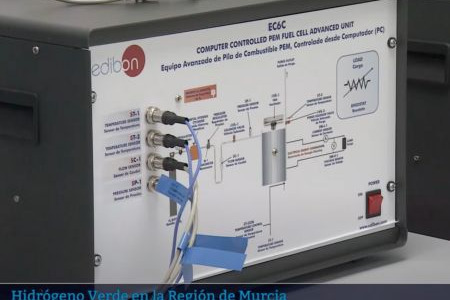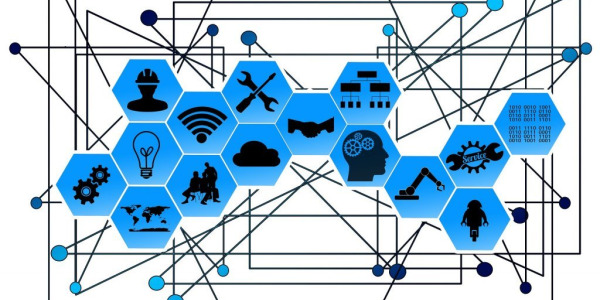The Smart Grid Power System with Power Generation, Transmission, Distribution and Loads, with SCADA, "AEL-CPSS-01S", has been designed by EDIBON for the training at both the theoretical and practical levels in the field of power generation, transmission, distribution, consumption, protections relays and micro-grids power systems.
The "AEL-CPSS-01S" application provides several levels of training to give the user full knowledge and experiences about the most important principles of control, operation and functioning of generation, transmission, distribution and load consumption. For this purpose, this application includes a specific manual, which explains at theoretical level the subjects relating to high voltage power systems. The thematic of the manual covers from basic principles of functioning, control and operation of electric generators and energy transmission up to energy consumption. On the other hand, it is provided a series of modules to put into practice all theoretical concepts previously studied in this manual.
One of the advantages of this application is its modularity and flexibility. This allows carry out different real power systems configurations. For example, the user can configure the classical power system formed by "Generation + Transmission/Distribution + Consumption" or he can configure a micro-grid sytem with "Generation + Consumption" working in stand-alone too. At any moment the user can synchronize the electric generator with the laboratory mains and he can develop a real energy distribution network.
In functional terms the whole system can be controlled either locally through the operation of switches, breakers and signals, and remotely through Data Acquisition and Control Software.
The "AEL-CPSS-01S" application includes a Data Control and Data Acquisition Software (AEL-CPSS-01S/CCSOF) for remote control of the power system. The SCADA control software allows carrying out the most important operations of real power systems such as speed and voltage control of the turbine and synchronous generator, coupling maneuvers of the generator with the mains (synchronization), standalone operations with the generator, loads commutation, current and voltage measurements in different points of the power system, etc.
The following is a description of the most important modules included in this application:
- N-PSUB3. Power Generation Substation Module 3. It is an industrial control and protection device of power generator groups with more than 150 configurable variables. The device provides different levels of accessibility for configuration. For example, the user can adjust the protection thresholds of overcurrent (50/51), over/under-voltage, over/under-frequency (81), inverse power, over/underspeed of the turbine (12), number of poles of the machine, nominal power, etc. In addition, for more advanced settings, it is possible to set the PID control system parameters under different operation conditions of the turbine-generator group. For example, when the generator is working in stand-alone or in parallel operation modes are used different PIDs.
During commissioning of generator the provided software allows monitoring voltage and frequency PID signals, perturbations, analysis and real time settings.
During motor-generator group start-up, it is possible to monitor the PID signals, to analyze the generator disturbances and to remake real time setting adjustments through the provided relay configuration software.
Due to the versatility of the Generator Protection and Control Relay Unit, EDIBON provides configured this device to work properly from scratch with the generator-motor group. In addition, it is provided a relay setting file to restore the relay to the initial configuration. On this way, the user can change any relay parameter and recovery the initial setting.
Turbine speed controller. This device allows controlling manually and automatically the turbine speed. Manual control allows the user to manage the turbine speed through a potentiometer included in this module. On the other hand, automatic control function is carried out by the generator protection and control relay unit with an analog signal of 0 - 10 V. On this way, the user can either study the whole system operations working autonomously, as a real power station works, or taking the manual control of the system to study the effects of the turbine speed changes in the electrical system.
Automatic voltage regulator. This device is designed for manual and automatic control of the current excitation of the synchronous generator. The regulator has a switch that allows the user to select the control mode. If manual control mode is selected, the current excitation of the synchronous generator can be controlled manually with a potentiometer and the effects of the generator output voltage can be seen. Automatic control mode allows the generator protection and control relay unit to take the control of the current excitation.
On this way, the user can study the operation of the complete system working autonomously, as a real power station works, or he can take the control of the installation to study the effects of the excitation change of the synchronous generator in the electrical system.
- N-AE1CD. Transmission Lines Simulation Digital Module. Transmission Lines Simulation Digital Module. This module represents basic concepts of the electric energy high-voltage three-phase transmission lines operation. It consists of resistors, inductances and capacitances that can be configured to simulate different transmission lines. Each one of the phases is represented following the concentrated parameters theoretical model, through a resistance series association and inductances, along with a parallel association between each one of them in a capacitance effect. In addition this module has several switches to provoke one, two or three broken lines to study unbalance effects in the electrical system.
- N-EALD. Network Analyzer Module with Oscilloscope and Data Acquisition. Network Analyzer Module with Oscilloscope and Data Acquisition. This device allows measuring all electrical parameters of the synchronous generator such as phase and line voltages, line currents, active, reactive and apparent powers, frequency, harmonics, etc.
- N-CAR35T3D. Three-phase Digital Bank of Commutable Resistors Module. This module is designed in order to carry out local consumption of the generated energy by the synchronous generator. This module has three switches to introduce three active power consumption stages. In addition, this loads module can be controlled from the SCADA.
- N-CAR36T3D. Three-phase Digital Bank of Commutable Inductances Module. Three-phase Digital Bank of Commutable Inductances Module. This module is designed in order to carry out local consumption of the generated energy by the synchronous generator. This module has three switches to introduce three reactive power consumption stages. In addition, this loads module can be controlled from the SCADA.
- N-CAR19T3D. Three-phase Digital Bank of Commutable Capacitors Module. Three-phase Digital Bank of Commutable Capacitors Module. This module is designed in order to carry out local consumption of the generated energy by the synchronous generator. This module has three switches to introduce three reactive power consumption stages. In addition, this loads module can be controlled from the SCADA.
- N-PPIM2. Instrumentation Module 2. Instrumentation Module 2. Analog instrumentation module to measure active and reactive powers, frequency and current excitation of the generator.
- N-ERP-MF01. Digital Fault Simulator Module.Digital Fault Simulator Module. This module allows to inject different kind of faults such as single-pole short circuit, two-pole short circuit and three-pole short circuit. All these faults can be injected with and without impedance
This application is supplied with the EDIBON Computer Control System (SCADA), and includes: The unit itself + Computer Control, Data Acquisition and Data Management Software Packages, for controlling the process and all parameters involved in the process.
 Preferências de cookies
Preferências de cookies



























